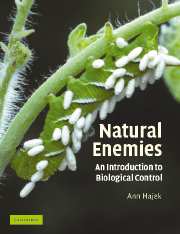Book contents
- Frontmatter
- Contents
- Preface
- Acknowledgments
- Introduction
- PART I Strategies for using natural enemies
- PART II Biological control of invertebrate and vertebrate pests
- Chapter 6 Ecological basis for use of predators, parasitoids, and pathogens
- Chapter 7 Predators
- Chapter 8 Insect parasitoids: attack by aliens
- Chapter 9 Parasitic nematodes
- Chapter 10 Bacterial pathogens of invertebrates
- Chapter 11 Viral pathogens
- Chapter 12 Fungi and microsporidia
- PART III Biological control of weeds
- PART IV Biological control of plant pathogens and plant parasitic nematodes
- PART V Biological control: concerns, changes, and challenges
- Glossary
- References
- Index
Chapter 6 - Ecological basis for use of predators, parasitoids, and pathogens
Published online by Cambridge University Press: 05 June 2012
- Frontmatter
- Contents
- Preface
- Acknowledgments
- Introduction
- PART I Strategies for using natural enemies
- PART II Biological control of invertebrate and vertebrate pests
- Chapter 6 Ecological basis for use of predators, parasitoids, and pathogens
- Chapter 7 Predators
- Chapter 8 Insect parasitoids: attack by aliens
- Chapter 9 Parasitic nematodes
- Chapter 10 Bacterial pathogens of invertebrates
- Chapter 11 Viral pathogens
- Chapter 12 Fungi and microsporidia
- PART III Biological control of weeds
- PART IV Biological control of plant pathogens and plant parasitic nematodes
- PART V Biological control: concerns, changes, and challenges
- Glossary
- References
- Index
Summary
Ecology may be the most intractable legitimate science ever developed.
(Slobodkin, 1988)The ultimate goal of biological control is to manipulate systems to maintain pest populations at low densities and thus prevent problems due to pests. It follows that biological control in long-lived ecosystems can be thought of as a type of “applied population dynamics” (Murdoch & Briggs, 1996). In fact, studies of natural enemies and their hosts have been the basis for many ecological studies investigating population regulation. The field of ecology has gained from this association but it has been questioned whether ecological theory, in turn, has helped biological control. There is indeed a new movement to try to use insights gained from ecological theory to help increase the success of biological control.
Information from the majority of population dynamics studies of natural enemies and their interactions with their hosts can have relevance to classical biological control. Information from these studies may also be relevant to conservation biological control in providing the information about correct conditions for optimization of activity of natural enemies. Inoculative releases are also dependent upon interactions between host and natural enemy, although not on a permanent basis, while basic theory on long-term dynamics of natural enemies and hosts may have little application to inundative releases, where initial releases are expected to control the pest. Because the vast majority of biological control of animals is focused on arthropods, we will discuss the ecological basis for biological control using arthropods as examples.
- Type
- Chapter
- Information
- Natural EnemiesAn Introduction to Biological Control, pp. 101 - 123Publisher: Cambridge University PressPrint publication year: 2004
- 1
- Cited by



